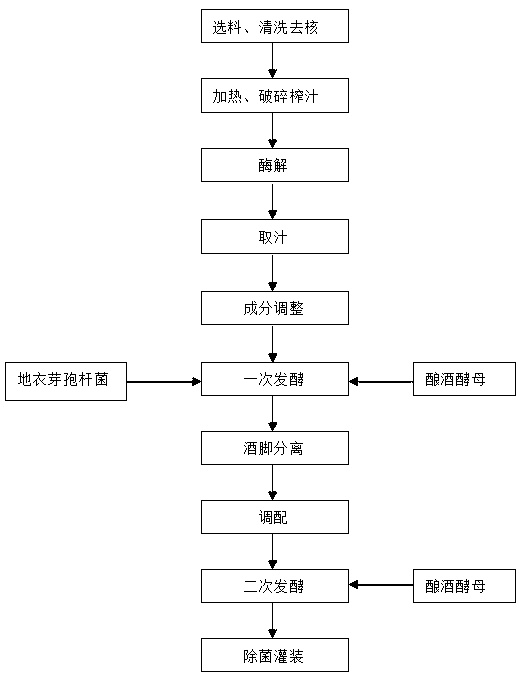Brewing method of dry sparkling loquat wine
A loquat wine and dry type technology is applied in the brewing field of dry type sparkling loquat wine, can solve the problems of human health hazards, no reports of dry type loquat sparkling wine, etc., and can promote the loss of calcium and avoid bad flavor. , the effect of preventing the growth of microorganisms
- Summary
- Abstract
- Description
- Claims
- Application Information
AI Technical Summary
Problems solved by technology
Method used
Image
Examples
Embodiment 1
[0038] A brewing method of dry sparkling loquat wine, characterized in that: the production steps are:
[0039] 1) material selection: select the loquat whose fruit is ripe and not rotten and whose appearance is clean and tidy as raw material;
[0040]2) Washing and removing the core: rinse the loquat with clean water, remove the fruit stem and core to obtain fresh pulp;
[0041] 3) Heating: put the fresh pulp obtained in step 2) into a fermenter, and raise the temperature to 80° C. within 3 minutes under the protection of carbon dioxide, and stir simultaneously during the heating process to obtain loquat pulp;
[0042] 4) crushing and squeezing the juice: pump the loquat fruit slurry obtained in step 3) into a vacuum tank, and keep the pressure at 100Pa under the protection of carbon dioxide. After the fruit slurry enters the vacuum tank, it expands rapidly, and the cell tissue ruptures. The pulp liquid is cooled to 35°C;
[0043] 5) Enzymolysis: Add pectinase to the fruit ...
Embodiment 2
[0052] A brewing method of dry sparkling loquat wine, characterized in that: the production steps are:
[0053] 1) material selection: select the loquat whose fruit is ripe and not rotten and whose appearance is clean and tidy as raw material;
[0054] 2) Washing and removing the core: rinse the loquat with clean water, remove the fruit stem and core to obtain fresh pulp;
[0055] 3) Heating: put the fresh pulp obtained in step 2) into a fermenter, and raise the temperature to 85° C. within 4 minutes under the protection of carbon dioxide, and stir simultaneously during the heating process to obtain loquat pulp;
[0056] 4) Crushing and squeezing the juice: pump the loquat fruit slurry obtained in step 3) into a vacuum tank, and keep the pressure at 80Pa under the protection of carbon dioxide. After the fruit slurry enters the vacuum tank, it expands rapidly, and the cell tissue ruptures. Cool the pulp to 38°C;
[0057] 5) Enzymolysis: Add pectinase to the fruit pulp obtaine...
Embodiment 3
[0066] A brewing method of dry sparkling loquat wine, characterized in that: the production steps are:
[0067] 1) material selection: select the loquat whose fruit is ripe and not rotten and whose appearance is clean and tidy as raw material;
[0068] 2) Washing and removing the core: rinse the loquat with clean water, remove the fruit stem and core to obtain fresh pulp;
[0069] 3) Heating: Place the fresh pulp obtained in step 2) into a fermenter, heat up to 85° C. within 4 minutes under the protection of nitrogen, and stir at the same time during the heating process to obtain loquat pulp;
[0070] 4) Broken and squeezed juice: pump the loquat fruit slurry obtained in step 3) into a vacuum tank, and keep the pressure at 60Pa under nitrogen protection. After the fruit slurry enters the vacuum tank, it expands rapidly, and the cell tissue ruptures. The pulp liquid is cooled to 37°C;
[0071] 5) Enzymolysis: Add pectinase to the fruit pulp obtained in step 4) for enzymolysis...
PUM
| Property | Measurement | Unit |
|---|---|---|
| pore size | aaaaa | aaaaa |
Abstract
Description
Claims
Application Information
 Login to View More
Login to View More - R&D Engineer
- R&D Manager
- IP Professional
- Industry Leading Data Capabilities
- Powerful AI technology
- Patent DNA Extraction
Browse by: Latest US Patents, China's latest patents, Technical Efficacy Thesaurus, Application Domain, Technology Topic, Popular Technical Reports.
© 2024 PatSnap. All rights reserved.Legal|Privacy policy|Modern Slavery Act Transparency Statement|Sitemap|About US| Contact US: help@patsnap.com









